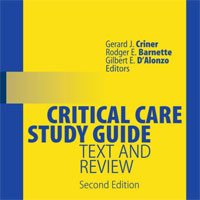Tag: research
New Approaches Reduces Inappropriate Antibiotic Usage
A UC Davis study of 9 emergency departments and urgent care centers in California and Colorado found educating physicians and patients about safe antibiotic use can cut overuse by 30%. The study, funded under a contract from... read more
Huddling for High Reliability and Situation Awareness
This study objectives were to explore hospital administrator and frontline staff perspectives on the benefits and challenges of implementing a tiered huddle system; and propose a model based on our findings depicting the... read more
Acute Kidney Injury in Cirrhosis
Novel biomarkers may assist in identification of acute tubular necrosis and persistent/severe acute kidney injury (AKI). Norepinephrine has been suggested to be inferior to terlipressin, with additional research required.... read more
Critical Care Study Guide: Text and Review
Critical care medicine is a dynamic and exciting arena where complex pathophysiologic states require extensive knowledge and up-to-date clinical information. An extensive knowledge of basic pathophysiology, as well as awareness... read more

Using Propensity Scoring Analyses in Critical Care Research
Observational studies are a common and important aspect of critical care research. A key challenge in the design of observational studies is the control of confounding. Confounding arises when the groups being compared in... read more
Level and Prevalence of Spin in Published Cardiovascular Randomized Clinical Trial Reports With Statistically Nonsignificant Primary Outcomes
In this systematic review that included 93 reports of Randomized Clinical Trials (RCTs) from 6 high-impact journals, positive spin of statistically nonsignificant primary outcomes was found in 57% of abstracts and 67% of... read more
The Rise of the Healthcare Administrator
Here's some food for thought: The number of physicians in the United States grew 150 percent between 1975 and 2010, roughly in keeping with population growth, while the number of healthcare administrators increased 3,200... read more
Effect of a Low vs Intermediate Tidal Volume Strategy on Ventilator-Free Days in ICU Patients Without ARDS
In patients in the Intensive Care Unit (ICU) without acute respiratory distress syndrome (ARDS) who were expected not to be extubated within 24 hours of randomization, a low tidal volume strategy did not result in a greater... read more
Pretreating red blood cells with nitric oxide may reduce side effect linked to transfusions
A new treatment may diminish a dangerous side effect associated with transfusions of red blood cells (RBCs) known as pulmonary hypertension, an elevated blood pressure in the lungs and heart that can lead to heart failure.... read more
An evaluation of the Swiss staging model for hypothermia using hospital cases and case reports from the literature
The Swiss staging model for hypothermia uses clinical indicators to stage hypothermia and guide the management of hypothermic patients. The proposed temperature range for clinical stage 1 is ... read more
Disease History to Predict Mortality Risk in ICU Patients
Patients in the intensive care unit are highly heterogeneous, and include elderly patients who generally have a long history of disease. Prediction of prognosis can often be difficult because of the severity of patient illness... read more
Environment key battle ground in fight to tackle antibiotic resistance
The environment could be as important a battle ground as the clinic in the global fight against the spread of antibiotic resistance, new research has shown. A study conducted at the University of Exeter Medical School concluded... read more
Physician Burnout Costs the U.S. Billions of Dollars Each Year
Doctors in the U.S. experience symptoms of burnout at almost twice the rate of other workers, often citing as contributors the long hours, a fear of being sued, and having to deal with growing bureaucracy, like filling out... read more
Multipotent Fetal-derived Cdx2 Cells From Placenta Regenerate the Heart
Researchers at the Icahn School of Medicine at Mount Sinai have demonstrated that stem cells derived from the placenta known as Cdx2 cells can regenerate healthy heart cells after heart attacks in animal models. The extremely... read more
Describing Organ Dysfunction in the ICU
Multiple organ dysfunction is a common cause of morbidity and mortality in intensive care units (ICUs). Original development of the Sequential Organ Failure Assessment (SOFA) score was not to predict outcome, but to describe... read more
Closed ICU Model Linked to 100% Reduction in Several HAIs
A closed intensive care unit model, in which a patient is evaluated and admitted under an intensivist and patient care orders are written by ICU staff, can help reduce rates of several healthcare-associated infections (HAI),... read more
Diagnostic error increases mortality and length of hospital stay in patients presenting through the emergency room
Diagnostic errors occur frequently, especially in the emergency room. Estimates about the consequences of diagnostic error vary widely and little is known about the factors predicting error. Our objectives thus was to determine... read more
Metabolic Acidosis: A Guide to Clinical Assessment and Management
This timely volume provides an overview to the causes, effects on systems and clinical approaches of metabolic acidosis. Beginning with a basic understanding of the physiology, pathophysiology and development of this disease,... read more

Unaccountable: What Hospitals Won’t Tell You and How Transparency Can Revolutionize Health Care
Dr. Marty Makary is co-developer of the life-saving checklist outlined in Atul Gawande's bestseller The Checklist Manifesto. A Johns Hopkins surgeon and professor of public health, he can testify to the amazing power of modern... read more

Anticoagulant Reversal
Ranjit Deshpande, MD, and Mark D. Cipolle, MD, PhD, FCCM, discuss Dr. Cipolle's talk from the 48th Critical Care Congress on what's new in anticoagulant reversal. Tune in to hear about the hottest topics and current research.... read more
Antibiotic Therapy for Severe CAP in the ICU
Researchers have assessed the impact antibiotic therapy on short (hospital) and long-term (6 months) outcomes of ICU patients with severe community-acquired pneumonia. Community-acquired pneumonia (CAP) remains one of the... read more
Disinfection Devices in ICU Sinks Dramatically Reduce Superbugs
Putting disinfection devices onto the siphons of sinks can help manage multidrug-resistant Pseudomonas aeruginosa colonization in intensive care units, according to a study published in Journal of Hospital Infection. Researchers... read more









